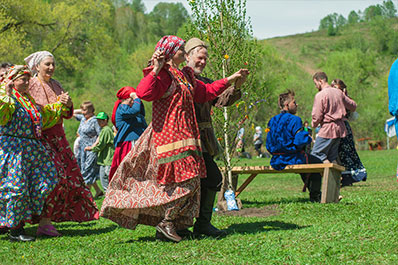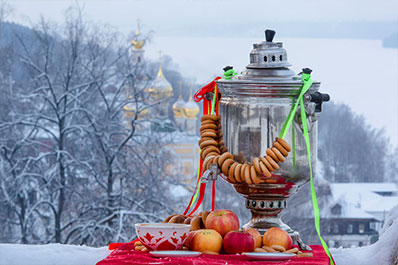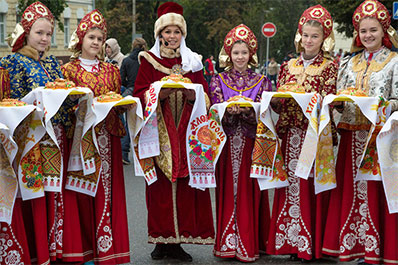For Russia, ethnic tourism and regional traditions are not usually its calling-card for tourists. Due to the Soviet Union’s determination to quash all variety from the human race; countless traditions, languages, religions and even entire nationalities were wiped out with the purportedly noble aim of achieving a perfectly equal and uniform society. Thankfully, the USSR’s tragic policy wasn’t successful in all regions and today, many of Russia’s diverse cultures are being revived.
Though most foreigners think of Russia as a slavic land, only the comparatively small western regions were historically slavic. In the endless tundra above the Artic Circle, nomads with their own distinct culture are still practically the only people capable of living through winters where the average temperature is an eyelash-freezing -40 c. Down south, in the belly of Russia’s central region, the world’s largest forest is home to Siberian shamans and buddhist temples. From there, follow the scent of dessert wind which leads to the balmy Caspian Sea and what was once a great Arabic city: Kazan. To this day, ancient mosques stand alongside some of Orthodox Christianity’s most important cathedrals in Russia’s capital of diversity and one of the best destinations for ethnic tourism in Russia.
Where to See the Real Russia?
- Velikiy Novgorod: The birthplace of Russia as we know it is undoubtedly the the best place to dive into slavic culture.
- Yakutia: The world’s coldest region is home to a people with a history and culture like no other. Sleep in yurts and help herd reindeer to find out more about the Yakutia’s nomads on an ethnic trip.
- Siberia: The strangest Russian traditions, like throat-singing and shamanism, all originate from Russia’s most famous region: Siberia.
- Kazan: East meets west in Kazan, a 1000 year old city with Arabic, Asian and Slavic influences.
Slavic Village Traditions
Russia’s most iconic symbols - the matryoshka, troika and samovar - all originated from the western region of Russia around St Petersburg and Moscow. Its boggy forests and open pastures were the sites of the first settlements made by slavs emigrating northwards from Kiev. The izbas or log houses which they built entirely from wood can still be found scattered in villages on the outskirts of cities. Some of these village settlements later developed into impressive stone-walled kremlins. For a chance to sleep on a pechka (a large stove with a bed on top) or to walk the walls of a medieval kremlin, the best destination for Russian ethnic tourism is Velikiy Novgorod: the birthplace of Russia.
Northern Nomads
The land where mammoths once roamed is now home to the world’s most prolific reindeer herds and polar bear hunters. After years of obscurity, the indigenous people are finally receiving the recognition they deserve. Intrepid travellers can now fly into the Artic circle and see how the world’s toughest people live. In Yakutia, the coldest region on earth, tourists are welcome to sled along with the locals during the week-long reindeers migrations and live in reindeer hide yurts. If you visit in winter, you may even be lucky enough to see the “great spirit of the sky” - the Northern lights.
Siberian Shamans
Siberia is so large that it seems to engulf the whole of Russia. In actual fact, it’s only encompasses the Asian side of Russia and, though today its population is predominantly slavic, it’s culture of mysticism reflects the east asian tribes which used to live here. In the south, the sound of gongs from buddhist temples reverberate across the waters of Lake Baikal and, in the Altai mountains, shamans still treat disease with wild herbs and honey. These traditions along with throat-singing and Russian yoga, can only be experienced on Siberia’s ethnic tours.
Eastern Eclecticism
One of the few places that retained its regional character throughout the USSR was the Republic of Tatarstan. Its capital, Kazan, is one of Russia’s oldest cities and its name, which means cauldron in Tatar, alludes to its diverse, bubbling culture. Its kremlin - with sky-blue domes and geometrical towers - shares more similarities with a giant mosque than the stolid red walls of Moscow’s kremlin and, along with century-old cathedrals and mosques, a unique temple of all religions stands proudly. Among the many ethnicities that live here, the most famous are the cossacks who can still be seen cantering down the streets on sandy-brown Don horses.




